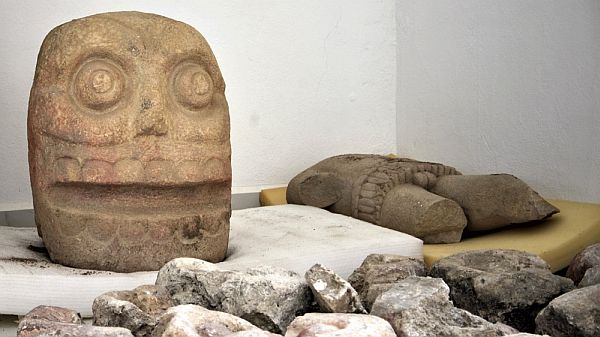Puebla, Mexico - Archaeologists in Mexico have found what is believed to be the first temple dedicated to a pre-Hispanic deity known as Xipe Totec, a god of fertility, war and agricultural cycles, who was worshipped with ritual sacrifices.
Historians have long known that Xipe Totec, whose name translates roughly as "the Flayed Lord," was worshipped by numerous peoples across what is now central and western Mexico and the Gulf coast.
But th discovery - made among the ruins of the Ndachjian-Tehuacan archaeological site in the central state of Puebla - is the first time a temple dedicated to the god has been found, Mexico's National Institute of Anthropology and History said in a statement.
According to the institute, priests sacrificed captives on one of the temple's two circular altars, then flayed them on the other and draped themselves in their skin to imitate Xipe Totec, who is often depicted wearing the skin of a sacrificial victim.
Stone Sculptures
Artifacts uncovered at the site include three stone sculptures of Xipe Totec: two depicting skinned heads and one of a torso, whose back is covered with engravings representing the sacrificial skins worn by the god, the institute said.
"Sculpturally speaking, [the torso sculpture is] a very beautiful piece. It measures approximately 80 centimeters tall and has a hole in the belly, which according to historical sources is where a green stone was placed to 'bring it to life' for ceremonies," Noemi Castillo Tejero, the lead archaeologist on the project said.
The skulls measure about 70 cm in height and weigh some 200 kg.
According to the institute, the objects were found at a site built by the Popoloca people, who began building in the area around CE 900 and were later assimilated into the sprawling Aztec kingdom, and would have been used from around the year 1000 until about 1260.
The Flayed Lord
According to the institute, Xipe Totec was one of the most important gods in pre-Hispanic Mexico and was worshipped in a ceremony called Tlacaxipehualiztli, which means "to wear the skin of the flayed one" in the indigenous Nahuatl language.
Sacrificial victims, who were often prisoners of war, were killed either through gladiatorial combat matches or by being shot with arrows, before being flayed to glorify Xipe Totec. Their skins were later buried at the foot of the altars.
Cult worship of Xipe Totec and other deities gradually died out following the expansion of the Aztec kingdom and the Spanish takeover of Mexico, which began in 1519 with the arrival of the conquistador Hernan Cortes.
Original article


